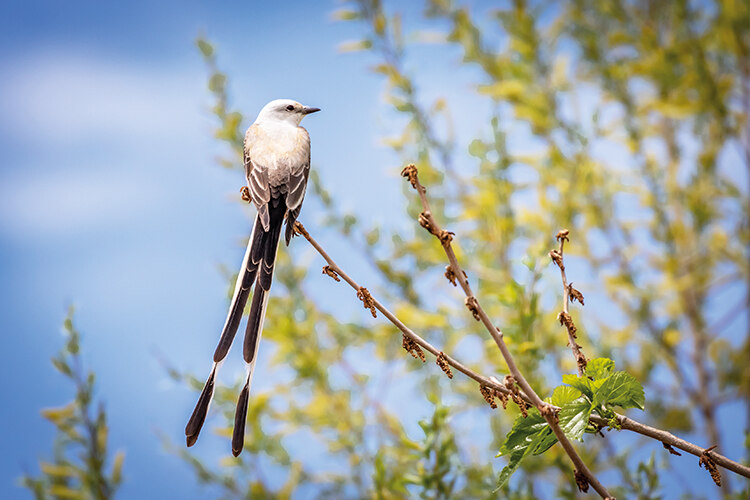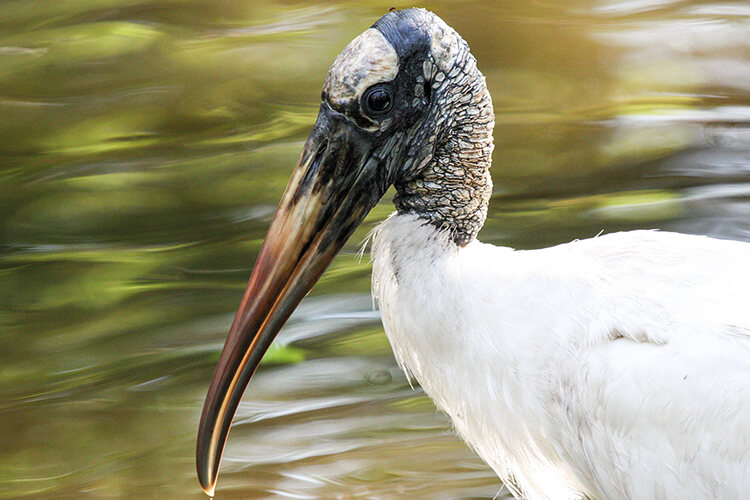
Alabama’s Black Belt region has some of the USA’s highest bird diversity. A new initiative is set to support conservation and help the region’s economic revival
Report by Geordie Torr
Imagine giving a house sparrow to a kindergartener with a bucket of paint.’ Scot Duncan, executive director of Alabama Audubon, is describing the painted bunting, one of the more outlandish birds found in the Black Belt region of Alabama. ‘We’ve also got scissor-tailed flycatchers. These guys have long-tail streamers that come out almost twice the length of their body. Those are a couple of the flagship species that we have here and we want them to stick around.’
Located in the southeastern USA, Alabama is remarkable for its collection of natural habitats – it’s said to host some 64 different terrestrial ecosystems, ranging from forest to prairie to swampland. And these habitats support a spectacular array of plants and animals. As Duncan tells it, ‘Alabama is a rock star when it comes to biodiversity. It has more native species than any state east of the Mississippi River and if you look at the total rankings across the entire US, we’re ranked number four; the only states that beat us are large western states – California, Texas and Arizona in that order.’

Unfortunately, however, Alabama hasn’t done a very good job of protecting that biodiversity. ‘We’re ranked number two in the US for total number of extinct species,’ Duncan explains. ‘Hawaii’s number one, and islands are really difficult places to maintain native biodiversity. So on the continent, we’re the number one state for extinctions and we’re ranked third for endangered species. So this isn’t just about past transgressions – these are problems that we’re still facing today.’
In order to try to help reverse this trend, Alabama Audubon has set up the Black Belt Birding Initiative, a programme designed to protect and enhance the bird fauna of one of the state’s most biodiverse but economically depressed areas. The crescent-shaped Black Belt region is a biologically and geologically distinct area that extends from southwestern Tennessee through east-central Mississippi and across central Alabama. It hosts the easternmost portion of the tallgrass prairie ecosystem – a biological community more commonly associated with the US Midwest. ‘There are unique bird communities in the Black Belt that you can’t find easily elsewhere in the Southeast,’ Duncan says. ‘They’re not endemic species, but there are a lot of grassland and prairie species that we typically find in the Midwest. And grassland bird species, as a whole, have really taken a hard hit here in North America because of the expansion of industrial agriculture.’
However, the Black Belt Birding Initiative isn’t just about birds. ‘The idea is to use ecotourism as a way to incentivise locals to be conservationists, and also to bring in revenue to a region that badly needs it. The Black Belt has been an underserved community for far too long,’ Duncan says. ‘It’s one of the poorest regions in the US. A lot of this goes back to its history.’


Back in the early to mid-1800s, when Alabama first became a state, the settlers eventually realised that the soil was perfect for growing cotton. ‘That led to the explosion of turning the Black Belt’s tallgrass prairie into fields of cotton,’ Duncan says. ‘And, of course, all of that was made economically viable by the enslavement of Africans and their descendants. So the whole economy was based on the soils and enslaved peoples. This went on until the Civil War and a bit beyond, but eventually it all came crashing down.’
Poor farming methods combined with Alabama’s high rainfall to wash the thick, dark, fertile soil away and cotton productivity declined. This, in turn, combined with the emancipation of the slaves. ‘Together, soil erosion and emancipation pretty much brought about the end of cotton farming in the Black Belt,’ says Duncan. The local economy shifted first towards growing soybeans and then peanuts before settling on raising beef cattle and catfish, farming systems that are typically based on large areas of land being managed by a few people. ‘So we wound up having the situation where there’s a lot of African American people who have lived in the Black Belt for generations – that’s their home, that’s their community – but there’s never been enough economic activity to help lift up the economy. So there’s a lot of poverty in the Black Belt and that’s all the more reason to look for ways to help lift up this region.’
The Black Belt does already have a relatively well-established tourism economy, focused largely on the history of the civil rights movement. The region hosted the famous Montgomery bus boycott of 1955–56, which made Rosa Parks a national hero, and is home to the church in which Martin Luther King Jr began his career as a preacher and the infamous Edmund Pettus Bridge, where policemen and white vigilante groups brutally attacked peaceful marchers with tear gas and nightsticks in an event now known as Bloody Sunday. To a certain extent, the Black Belt Birding Initiative hopes to piggyback on this existing popularity.

One of the initiative’s most visible activities thus far is the Black Belt Birding Festival, which Alabama Audubon puts on each August. ‘August is brutally hot. It’s humid, too, so it’s a really tough time to do the festival,’ Duncan says. ‘The reason we do it then is because of a bird phenomenon that can happen in the Black Belt at that time of year – and pretty much only that time of year.’
The phenomenon in question involves a striking black-and-white bird called the swallow-tailed kite. ‘At that time of year, the kites have already bred – the chicks have fledged – so you have adult birds and fledglings that will eventually head down to Central and South America for the winter,’ Duncan says. ‘But it’s too early and they need to fatten up for that trek. They wander out into different areas where they can find lots of food and one of them is the Black Belt.’
In August, the farmers harvest the hay, which kicks up a lot of grasshoppers and other insects. ‘Within a fairly short period, you can have dozens of kites swirling around catching the insects,’ Duncan explains. ‘Most people have never seen these kites before, or they’ve seen them at a distance, and here they’re swooping by, sometimes at head level. It’s absolutely stunning.’
Interestingly, it was the spectacle of the kites swarming around the hay fields that acted as one of the progenitors of the initiative and sparked its most significant success story to date. What was then the Birmingham Audubon Society had been organising field trips to the region for some time, but the visiting groups rarely spent much money there. With that in mind, the then executive director, Ansel Payne, had been hoping to find local African-American landowners with whom the society might partner to bring ecotourism and conservation to the Black Belt. During a field trip in the summer of 2018, birders had watched from afar as kites swirled around Cornelius Joe and his son Christopher as they mowed the hay fields on their 80-hectare multi-generational, family-owned black Angus cattle farm. ‘I remember seeing some cars off the highway in the distance,’ Chris later told birdcollective.com. ‘I had no idea what they were doing, but it turns out they were watching the kites.’

Chris had been looking for ways to bring people to the farm as a way of diversifying its income, and having come across photos on Instagram of the Birmingham Audubon Society outing, he reached out to the organisation. The end result is a close partnership between the farm and the society – and the formulation of the Black Belt Birding Initiative.
Today, the farm hosts the birding festival, ferrying people around in a custom-made six-metre trailer with a spring-loaded rear ramp and harvesting the hay on the day. The family’s nascent birding business, Connecting with Birds and Nature Tours, hosts tours and other events on the farm throughout the rest of the year. ‘Chris has become something of a celebrity, in terms of bringing attention to the Black Belt,’ Duncan says. ‘He’s getting lots of media attention.’ The family actively promotes hotels and restaurants around the region in the hope that visits to the farm will have a larger impact.
Unsurprisingly, the runaway success of the bird tours on the Joe farm has sparked interest from a number of other local landowners, who have begun to express a desire to explore the possibility of moving into ecotourism. ‘We advise them on things like, what is it that birdwatchers want to see, which birds people want to see, what time of year they’re going to be present, how to manage your landscapes so that these birds will be present and abundant,’ Duncan says. ‘And we also help with getting that information out to the world so that people know that there are these places they can come to the Black Belt to stay and enjoy the bird life.’
Trail Blazing
Alabama is justly proud of its bird fauna (to the point where 2023 has been declared the Year of Alabama Birding). According to the Alabama Ornithological Society’s official state list, 420 species can be found within its borders.
In order to capitalise on this diversity, and to help people appreciate it, the Alabama Tourism Department has overseen the development of a series of birding trails across the state. ‘It started in the late 1990s,’ explains Joe Watts, a past president of Alabama Audubon, who was instrumental in developing many of the trails. ‘The folks along the coast, which is renowned for great birding, decided that they wanted to find a way to increase the economic impact of having birders coming in, to get them to stay a little bit longer by making it easier for people to find good birding locations. So they built the coastal birding trail, which features 50 locations around the Alabama coast. Then the North Alabama folks said, “Hey, this is working really well for the coast. Let’s do it in North Alabama,” which is where we get a lot of sandhill cranes. And sometimes about 15 of the less than 700 total world whooping crane population spend the winter in North Alabama.’
The tourism department then decided to expand the programme to cover the whole state, which led to the creation of six more trails, including one across the Black Belt. ‘We got together small groups of people in each region to talk about which locations were good for birds and to work with the local chambers of commerce so that they understood what birding could bring to their community,’ Watts explains. ‘Then we got some local volunteers from the Birmingham Audubon Society to go out and scout the locations, which turned into about 180 locations around the state, excluding north and coastal Alabama. We hired a naturalist to go out and do write ups of what species and what kind of habitats there were at each location. It was a pretty in-depth, several-year process of making sure that we were picking places that were good for birds, but also places that were geographically diverse.’
The resulting website is remarkably comprehensive. Each entry has maps and information on logistics, how to get to the sites, what to expect while you’re there, the best times a year to visit and of course, what birds you might see.
One of the sites on the Black Belt trail is Perry Lakes Park in Perry County, home to several oxbow lakes and cypress swamps. ‘It’s a favourite place for birds of the region to go visit, but they had to shut it down because it needed some repair and maintenance. A couple of years ago, our staff helped to raise the funds needed for the restoration,’ says Duncan. The park features a newly rebuilt 30-metre-tall birding tower. ‘Birders can get up above the canopy or stay in the canopy and look for warblers and other birds.’
To learn more, visit alabamabirdingtrails.com
For more information, visit alaudubon.org




